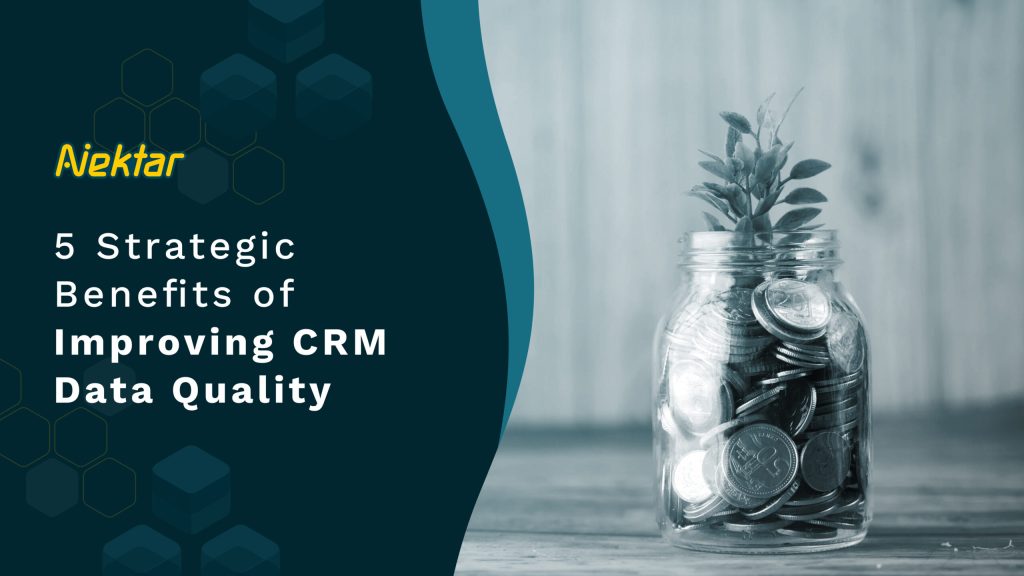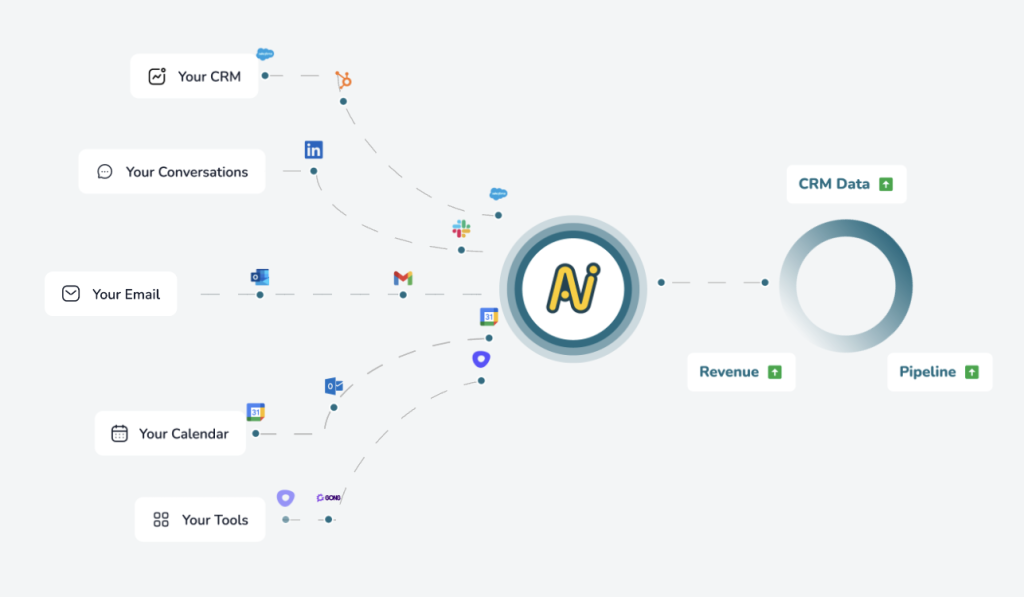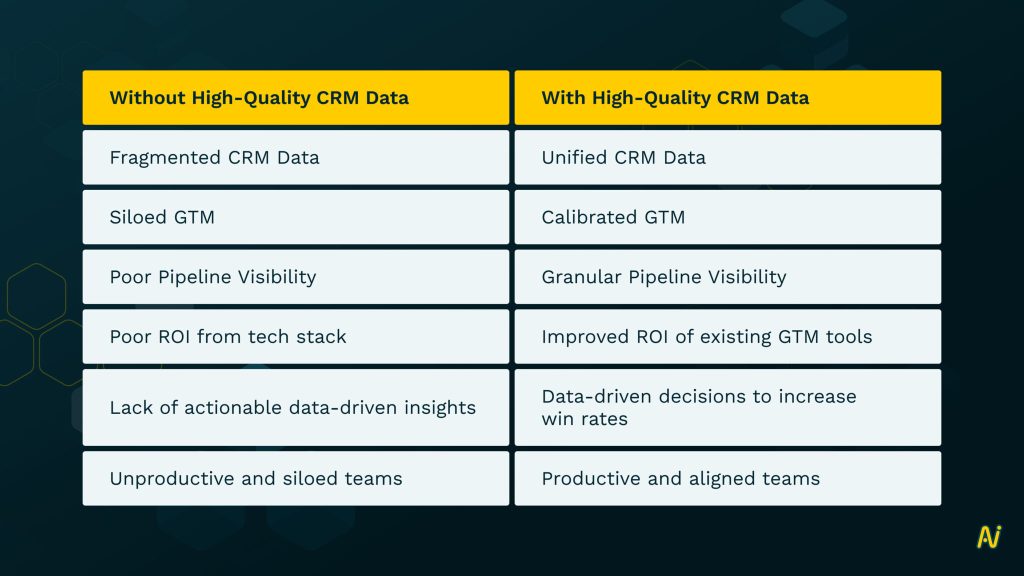Fixing your CRM data quality can have a direct impact on your bottom line and fix several unknown revenue gaps.
Here are some use top cases we have seen on how actionable insights from superior CRM data quality has helped revenue teams create a predictable and scalable revenue engine.
1. Accurate visibility of GTM funnel
To accelerate pipeline development, your frontline sales, marketing and customer success teams need to work together with high-quality CRM data.
With CRM data that is accurate and reliable, your GTM funnel is aligned and the entire organization refers to a single set of data-driven insights to work towards common goals.
With this kind of data-driven alignment, a lot of leakages get addressed at the root level. All your customer-facing teams have better visibility across the sales pipeline. You have better insights into the health of your pipeline, and everyone has answers to key questions like:
- How many qualified leads are there in the pipeline?
- Which contacts are most likely to engage with your sales or marketing efforts?
- Which leads should you disqualify?
For example, if the sales team notices that an important deal is stuck at a particular stage in the pipeline, and insights tell you that sharing a case study at that stage makes it more likely to accelerate the deal, they can work with marketing to get the same done. In this example, sales and marketing can work together with a common goal of moving a deal from one stage to another. And both can see the impact of their collaboration in the pipeline.
Marketing can be sure of the leads they pass on to sales. Your chances of generating more qualified leads increases. For example, you can capture missing contacts that can indirectly help your inside sales team as they are able to reach out to all those additional contacts in account. These people which you previously didn’t even know about can now be reached out to and potentially closed.
2. Increased focus on deals that convert
Your sales pipeline might get bloated with opportunities over time that add little to no value to your revenue. This can happen when your sales reps do not want to eliminate any deal opportunity, even if no conversations have happened in a long time.
Your reps might also believe that the bigger their pipeline, the more value it holds. However, the truth is that the more time reps spend on deals that have no future, the less is their quota attainment. Every minute spent on an unreal deal is time taken away from a deal that could close.
With complete and accurate CRM data, you can generate insights that tell you exactly which deals need to be eliminated from the pipeline so that your teams can divert their resources towards the most critical accounts.
Insights generated from accurate and complete CRM data gives sales managers a clear picture of where the pipeline looks bloated. They can take quick action on stalled deals and decide how to drive predictable quarters for themselves.
For example, by tracking the activity data of your reps in the CRM, you can use it as a leading indicator to determine which deals are real and focus only on those that convert.
3. High engagement with the buying committee
Selling is all about relationships. Making relationships with the customer, and nurturing them with time. But the buyer is no longer a single person in B2B sales. According to Gartner, the number of buyers in a group has increased from 5 to 20 in the last ten years.
63% of these key stakeholders are outside the IT department. Not just this, 80% of sales reps lose a deal when a key stakeholder quits their job.
As a result, it’s harder for sellers to validate the key stakeholders in the buying group, let alone engage with each of them.
Sellers not only need to know all the members in the buying committee, they also need to know which ones are the decision makers. And without the right data, sellers are left scrambling to identify who they should actually be pitching to in a buying group.
The result is lost deals, poor outreach and wasted hours on making ppt’s that are sent to the wrong person altogether!
Data and intelligence on your key buyers is a critical part of creating and maintaining strong relationships with your accounts. The right data can help your sellers get visibility into the personas that need to be targeted to fully influence the buying group at an account or opportunity level. The real challenge is finding the data, capturing it and quickly putting the pieces together for your teams to see.
For example, tools like Nektar help capture and match contact information to the corresponding opportunity automatically. This has a huge impact on who you target in the buying committee and how you engage with them. Sales teams can quickly and easily uncover answers to the questions they need to predict revenue and accelerate deals.
4. Hyper-personalized ABM campaigns
The days of “spray and pray” in marketing are over. Today’s buyers expect messaging that is customized to their unique pain points. They want solutions at their preferred time and choice of medium (digital channels or in-person).
According to Forrester, 60% of buyers say sellers who are knowledgeable and address their needs have the most positive impact on their buying decisions. And a study by Infosys found that 86% of consumers say personalization plays a role in their purchasing decisions.
Personalized campaigns are proven ways of increasing revenues by 5 to 15 percent and increasing market spend efficiency by 10 to 13 percent. As per McKinsey, personalization will be the prime driver of marketing success. Organizations that know how to segment their audiences and build robust account-based marketing campaigns to capture and nurture them will emerge successful.
But building powerful ABM campaigns relies heavily on CRM data quality. And data remains an obstacle to do personalization right. A majority of revenue leaders from our survey don’t feel confident in their ability to create personalized, omnichannel buying experiences at scale. As less as 15% of CMOs believe their company is on the right track with personalization.
Such data quality shortcomings in CRMs are making marketing and sales teams underperform and fail on their personalized outreach strategies. With good quality and trustworthy CRM data, GTM teams can access greater intelligence and accuracy when it comes to their personalization efforts.
Mass emails will get replaced by lower volume, but more targeted approaches. With the right data strategy, sales and marketing teams can invest in what converts and not just what clicks.
Organizations can use enriched data in their CRM to reach each segment of their customer base with a meaningful omni-channel approach and successfully execute ABM strategies at scale. Clean CRM data with AI-led revenue intelligence can facilitate this kind of strategy and engage high-potential prospects.
5. Reduced operational cost of bad data
The more dirty data you collect, the more problems your database will create. This bad data causes severe revenue losses like high customer churn, failed marketing campaigns, and lower productivity among your teams. This cost in the US alone is $3.1 trillion annually, while individual organizations can lose $9.7 million per year.
The quality of your CRM data will have a direct impact on the costs of maintaining it. As your data continues to grow, its management costs grow exponentially along with it. Data cleansing in itself can be a huge financial burden for your business. Data scientists spend 80% of their time cleaning data rather than creating insights.
Clean data can clear a lot of such operational costs that come with management of bad data. For example, using inaccurate data to drive ABM campaigns can lead to higher customer churn, a higher probability of emails bouncing or targeting the wrong people altogether. This can increase operational costs by leaps and bounds in the form of acquiring returns on CRM investment or loss of productivity among your sales reps because of manual entry.
With clean and accurate data that automatically enters your CRM, and gets enriched as things move at lightning fast speed, you can reduce these operational risks and save more revenue.
Proper CRM data management is a continuous process in this regard. And it can reduce your storage costs by 7% and management costs by 5%. Your reps save enormous amounts of time from ditching manual entry by as high as 79% – which leads to increased productivity.








